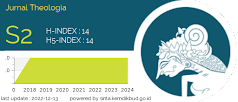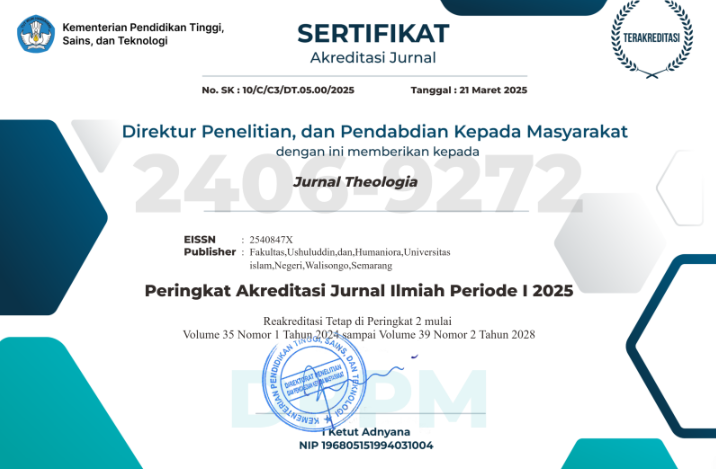Contemporary Qur’anic Lithography in Indonesia: Aesthetic of Reception of the Marble Al-Qur’an Manuscript
DOI:
https://doi.org/10.21580/teo.2022.33.2.12788Keywords:
Aesthetic Reception, Marble Al-Qur’an Manuscript, Qur’anic LithographyAbstract
This study discusses the marble manuscripts of the Al-Qur’an and the meaning of its aesthetic reception manuscripts. The type of research is field research with the research locus at Masjid Al-Muhtaram, Kajen, Pekalongan Regency as a place to store the marble stone manuscripts. This study used Wolfgang Iser’s reception theory. Therefore, the results of this study are (1) the marble stone Manuscript of the Qur’an made by Nur Hidayat Siba that started in 2011 until 2021. It has reached 13 juz of Qur’an derived from marble measuring 60 x 90 cm with a marble thickness of 2 cm. It is also written with beautiful khat and gold colour wrapping on every khat. (2) Those manuscript provides three meanings of aesthetic reception. First, the objective meaning of the Qur’an as a holy book must be preserved through beautiful media as a form of appreciation for the greatness of the Qur’an. Second, the expressive meaning is used as a medium of Islamic da’wah, and spirituality increases faith and religious aspects for those who see and read it. Third, the meaning of documentary as a form of habitus to always interact with the Qur’an in everyday life.
Downloads
References
Abshor, M. U. (2019). Resepsi Al-Qur’an Masyarakat Gemawang Mlati Yogyakarta. Qof, 3(1).
Al-Baihaqi. (1408 H). Dalail al-Nubuwwah Juz II. Kairo: Dar al-Kutub al-‘Ilmiyyah.
Al-Qurtubi, S. (2002). Al-Jami’ lii Ahkaam al-Qur’an (XVII). Dar Alam al-Kutb.
Al-Zarqani. (1996). Manāhil al-‘Irfān Juz 1. Dār al-Kutub al-‘Ilmiyyah.
Akbar, Ali. (2004) “Menggali Khazanah Nusantara: Telaah Ragam Gaya Tulisan dalam Mushaf Kuno”, Lektur Keagamaan, Vol. 2, No. 1, Jakarta: Puslitbang Lektur Keagamaan.
Amin, M. (2020). Resepsi Masyarakat Terhadap Al-Quran (Pengantar Menuju Metode Living Quran). Jurnal Ilmu Agama, 21(2).
Amstrong, Karen. (2014). Sejarah Tuhan cet. X, terj. Zaimul Am. Bandung: Mizan.
Baidowi, A. (2007). Resepsi Estetis Terhadap Al-Qur’an. Esensia, 8(1), 20.
Elrud-Ibsch, F. and. (1998). Teori Sastra Abad Kedua Puluh. Gramedia.
Endraswara, S. (2003). Metodologi Penelitian Antropologi Sastra. Penerbit Ombak.
Esack, F. (2002). The Quran: A Short Introduction. Oneworld Publication.
Fadlillah, N. (2017). Resepsi Terhadap Alquran dalam Riwayat Hadis. Nun, 3(2), 103.
Fathurrosyid. (2015). Tipologi Ideologi Resepsi Al-Quran di Masyarakat Sumenep Madura. El Harakah, 17(2).
Gade, Anna M. (2010). The Qur’an: An Introduction. Oxford: Oneworld Publications.
Goldziher, Ignaz. (1403 H). Mazahib al-Tafsir al-Islami. Beirut: Dar al-Iqra.
Iser, W. (1978). The Act of Reading: a Theory of Esthetic Response. The John Hopkins University Press.
Iswatunnisa, Khalida. (2015). Keserasian Bunyi Akhir dalam Al-Qur’an Surah al-Insyirah (Kajian Aspek Fonologi terhadap Al-Qur’an), Skripsi UIN Sunan Kalijaga Yogyakarta, Xvi.
Jannah, I. L. (2017). Resepsi Estetik Terhadap Al-Quran di Lukisan Kaligrafi Syaiful Adnan. Nun, 3(1).
Jannah, M. (2016). Musabaqah Tilawah Al-Qur’an di Indonesia (Festivalisasi Al-Qur’an Sebagai Bentuk Resepsi Estetis. Jurnal Ilmu Ushuluddin, 15(2).
Kermani, N. (1999). Gott ist schön Das Aesthetische Erleben des Koran. C.H. Beck.
Khosim, M. (2019). Resepsi Estetis Qur’ani dalam Musik Rock Sholawat Rofa Band Di Bantul Yogyakarta. Jurnal Studi Ilmu-Ilmu Al-Qur’an Dan Hadis, 20(2), 187–202.
Kuswarini, P. (2016). Penerjemahan, Intertekstualitas, Hermeneutika Dan Estetika Resepsi. Jurnal Ilmu Budaya, 4(1).
Lajnah Pentashihan Mushaf Al-Qur'an Badan Litbang dan Diklat Kementerian Agama RI. (2020). Penelitian Mushaf Al-Quran Cetak Pasca-Penetapan Mushaf Standar Indonesia 1984: Penguatan Regulasi, Layanan, dan Mutu SDM Pentashihan. Policy Paper, 1-2.
Lukman, F. (2015). Epistemologi Intuitif Dalam Resepsi Estetis H.B. Jassin Terhadap Al-Qur’an. Journal of Qur’an and Hadith Studies, 4(1).
Masrurin, A. (2018). Resepsi Alquran Dalam Tradisi Pesantren Di Indonesia (Studi Kajian Nagham Alquran Di Pondok Pesantren Tarbitayul Quran Ngadiluweh Kediri). Al-Bayan: Jurnal Studi Al-Qur‘An Dan Tafsir, 3(2), 101–118.
Michael, B. M. M. dan H. A. (1994). Qualitative Data Analysis. SAGE Publications.
Muhammad. (2007). Mengungkap Pengalaman Muslim Berinteraksi dengan Quran. In S. Syamsudin (Ed.), Metodologi Penelitian Living Qur’an (p. 15). TH Press.
Mustopa, Pencetak Mushaf Generasi Pertama di Indonesia, https://lajnah.kemenag.go.id/artikel/620-pencetak-mushaf-generasi-pertama-di-indonesia, diakses pada 10 September 2021.
Mustaqim, A. (2015). Metode Penelitian Al-Qur’an dan Tafsir. CV. Idea Sejahtera.
Muttaqin, A. (2017). Resepsi Estetis H.B. Jasin Terhadap Ayat Metafora dalam Bingkai Teori Kritik Sstra. Suhuf, 10(2), 307–326.
Nasr, S. H. (1997). Islamic Art and Spirituality. Sauhail Academy.
Nurfuadah, H. (2017). Living Quran: Resepsi Komunitas Muslim Pada Alquran (Studi Kasus Di PP. At-Tarbiyyatul Wathoniyyah Desa Mertapada Kulon, Kec. Astatana Japura, Kab. Cirebon). Diya Al-Afkar, 5(1).
Pahala, A. A. (2018). Resepsi Estetik Pada Lukisan Kaligrafi Sakban Yadi. Tarbiyatuna, 9(1), 3.
Perho, I. (2010). Pengobatan dan Alquran. In Alquran Sains dan Ilmu Sosial (p. 84). Elsaq Press.
Pradopo, Rachmat Djoko. (2007). Beberapa Teori Sastra: Metode Kritik dan Penerapannya. Yogyakarta: Pustaka Pelajar.
Purnama, R. F. (2020). The Aesthetic Reception Of Quran In Instagram: Variation, Factor, And Religious Commodification. Ulul Albab, 21(2).
Rafiq, A. (2004). Pembacaan yang Atomistik terhadap al Qur’an; Antara Penyimpangan dan Fungsi. Jurnal Studi Al-Qur’an Dan Hadits, 4(1), 3–5.
Rafiq, Ahmad. (2012). “Sejarah Alquran: Dari Pewahyuan ke Resepsi (Sebuah Pencarian Awal Metodologis)”. Dalam Islam Tradisi dan Peradaban. Yogyakarta: Suka Press, 73.
Rafiq, A. (2015). Faḍāil al-Qur’ān. In A. Mustaqim (Ed.), Melihat Kembali Studi Alquran: Gagasan dan Tren Terkini (pp. 42–43). Idea Press.
Ratna, Nyoman Kutha. (2009). Teori, Metode, dan Teknik Penelitian Sastra. Yogyakarta: Pustaka Pelajar.
Riani, A. (2019). 5 Al-Quran Unik di Indonesia, Terbuat dari Marmer hingga Bertinta Emas. Liputan 6.Com.
Riyadi, F. (2014). Resepsi Umat Atas Alquran: Membaca Pmikiran Navid Kermani Teori Resepsi Alquran. Hunafa, 11(1), 43–60.
Rohimin. (2016). Jejak dan Otoritas Pencetakan Mushaf Alquran di Indonesia, Jurnal Nuansa, IX (2), 191-192
Setiawan, M. Nur Kholis. (2006). Alquran Kitab Sastra Terbesar. Yogyakarta: eLSAQ Press
Sukarno, S. (2021). Indahnya Al Quran Berbahan Marmer di Masjid Al Muhtarom Pekalongan. Jateng Inews.
Zaman, A. R. B. (2019). Resepsi Al-Qur’an Di PP. Al-Hidayah Karangsuci Purwokerto. Maghza, 4(1).
Interview
Siba, Nur Hidayat. (2021, 09 03). “Interview of Qur’anic Lithography in Muhtaram Mosque, Pekalongan”.
Supriyanto. (2021, 09 03). “Interview of Qur’anic Lithography in Muhtaram Mosque, Pekalongan”.
Noto, Agus. (2021, 09 03). “Interview of Qur’anic Lithography in Muhtaram Mosque, Pekalongan”.
Pertiwi, Hanum. (2021, 09 03). “Interview of Qur’anic Lithography in Muhtaram Mosque, Pekalongan”.
Rihayana. (2021, 09 03). “Interview of Qur’anic Lithography in Muhtaram Mosque, Pekalongan”.
Syafa' (2021, 09 03). “Interview of Qur’anic Lithography in Muhtaram Mosque, Pekalongan”.
Riyas al-Baihaqi (2021, 09 03). “Interview of Qur’anic Lithography in Muhtaram Mosque, Pekalongan”.




















